Hangzhou Hikvision Digital Technology MH2211 Body Camera User Manual
Hangzhou Hikvision Digital Technology Co., Ltd. Body Camera
User Manual

Body Camera Quick Start Guide
1
Quick Start Guide
COPYRIGHT © 2017 Hangzhou Hikvision Digital Technology Co., Ltd.
ALL RIGHTS RESERVED.
Any and all information, including, among others, wordings, pictures, graphs are the properties of Hangzhou
Hikvision Digital Technology Co., Ltd. or its subsidiaries (hereinafter referred to be “Hikvision”). This user manual
(hereinafter referred to be “the Manual”) cannot be reproduced, changed, translated, or distributed, partially or
wholly, by any means, without the prior written permission of Hikvision. Unless otherwise stipulated, Hikvision
does not make any warranties, guarantees or representations, express or implied, regarding to the Manual.
About this Manual
This Manual is applicable to Body Camera.
The Manual includes instructions for using and managing the product. Pictures, charts, images and all other
information hereinafter are for description and explanation only. The information contained in the Manual is
subject to change, without notice, due to firmware updates or other reasons. Please find the latest version in the
company website (http://overseas.hikvision.com/en/).
Please use this user manual under the guidance of professionals.
Trademarks Acknowledgement
and other Hikvision’s trademarks and logos are the properties of Hikvision in various jurisdictions.
Other trademarks and logos mentioned below are the properties of their respective owners.
Legal Disclaimer
TO THE MAXIMUM EXTENT PERMITTED BY APPLICABLE LAW, THE PRODUCT DESCRIBED, WITH ITS HARDWARE,
SOFTWARE AND FIRMWARE, IS PROVIDED “AS IS”, WITH ALL FAULTS AND ERRORS, AND HIKVISION MAKES NO
WARRANTIES, EXPRESS OR IMPLIED, INCLUDING WITHOUT LIMITATION, MERCHANTABILITY, SATISFACTORY
QUALITY, FITNESS FOR A PARTICULAR PURPOSE, AND NON-INFRINGEMENT OF THIRD PARTY. IN NO EVENT WILL
HIKVISION, ITS DIRECTORS, OFFICERS, EMPLOYEES, OR AGENTS BE LIABLE TO YOU FOR ANY SPECIAL,
CONSEQUENTIAL, INCIDENTAL, OR INDIRECT DAMAGES, INCLUDING, AMONG OTHERS, DAMAGES FOR LOSS OF
BUSINESS PROFITS, BUSINESS INTERRUPTION, OR LOSS OF DATA OR DOCUMENTATION, IN CONNECTION WITH
THE USE OF THIS PRODUCT, EVEN IF HIKVISION HAS BEEN ADVISED OF THE POSSIBILITY OF SUCH DAMAGES.
REGARDING TO THE PRODUCT WITH INTERNET ACCESS, THE USE OF PRODUCT SHALL BE WHOLLY AT YOUR OWN
RISKS. HIKVISION SHALL NOT TAKE ANY RESPONSIBILITES FOR ABNORMAL OPERATION, PRIVACY LEAKAGE OR
OTHER DAMAGES RESULTING FROM CYBER ATTACK, HACKER ATTACK, VIRUS INSPECTION, OR OTHER INTERNET
SECURITY RISKS; HOWEVER, HIKVISION WILL PROVIDE TIMELY TECHNICAL SUPPORT IF REQUIRED.
SURVEILLANCE LAWS VARY BY JURISDICTION. PLEASE CHECK ALL RELEVANT LAWS IN YOUR JURISDICTION BEFORE
USING THIS PRODUCT IN ORDER TO ENSURE THAT YOUR USE CONFORMS THE APPLICABLE LAW. HIKVISION
SHALL NOT BE LIABLE IN THE EVENT THAT THIS PRODUCT IS USED WITH ILLEGITIMATE PURPOSES.
IN THE EVENT OF ANY CONFLICTS BETWEEN THIS MANUAL AND THE APPLICABLE LAW, THE LATER PREVAILS.

Body Camera Quick Start Guide
2
Regulatory information
FCC information
FCC compliance: Please take attention that changes or modification not expressly approved by the party
responsible for compliance could void the user’s authority to operate the equipment.
Note: This product has been tested and found to comply with the limits for a Class B digital device, pursuant to
Part 15 of the FCC Rules. These limits are designed to provide reasonable protection against harmful interference
in a residential installation. This product generates, uses, and can radiate radio frequency energy and, if not
installed and used in accordance with the instructions, may cause harmful interference to radio communications.
However, there is no guarantee that interference will not occur in a particular installation. If this product does
cause harmful interference to radio or television reception, which can be determined by turning the equipment
off and on, the user is encouraged to try to correct the interference by one or more of the following measures:
—Reorient or relocate the receiving antenna.
—Increase the separation between the equipment and receiver.
—Connect the equipment into an outlet on a circuit different from that to which the receiver is connected.
—Consult the dealer or an experienced radio/TV technician for help.
FCC conditions
This device complies with part 15 of the FCC Rules. Operation is subject to the following two conditions:
1. This device may not cause harmful interference.
2. This device must accept any interference received, including interference that may cause undesired operation.
EU Conformity Statement
This product and - if applicable - the supplied accessories too are marked with "CE" and comply therefore with
the applicable harmonized European standards listed under the Radio Equipment Directive 2014/53./EU, the
EMC Directive 2014/30/EU, the LVD Directive 2014/35/EU, the RoHS Directive 2011/65/EU.
2012/19/EU (WEEE directive): Products marked with this symbol cannot be disposed of as unsorted
municipal waste in the European Union. For proper recycling, return this product to your local
supplier upon the purchase of equivalent new equipment, or dispose of it at designated collection
points. For more information see: www.recyclethis.info.
2006/66/EC (battery directive): This product contains a battery that cannot be disposed of as
unsorted municipal waste in the European Union. See the product documentation for specific
battery information. The battery is marked with this symbol, which may include lettering to indicate
cadmium (Cd), lead (Pb), or mercury (Hg). For proper recycling, return the battery to your supplier
or to a designated collection point. For more information see: www.recyclethis.info.
Industry Canada ICES-003 Compliance
This device meets the CAN ICES-3 (B)/NMB-3(B) standards requirements.
This device complies with Industry Canada licence-exempt RSS standard(s). Operation is subject to the following
After the laboratory measurement, the Max SAR value is 0.27W/kg for 2.4G Band which satisfies the RF
exposure requirement
After the laboratory measurement, the Max SAR value is 0.27W/kg for 2.4G Band which satisfies the RF
exposure requirement

Body Camera Quick Start Guide
3
two conditions:
1) this device may not cause interference, and
2) this device must accept any interference, including interference that may cause undesired operation of the
device.
Le présent appareil est conforme aux CNR d'Industrie Canada applicables aux appareils radioexempts de licence.
L'exploitation est autorisée aux deux conditions suivantes :
1) l'appareil ne doit pas produire de brouillage, et
2) l'utilisateur de l'appareil doit accepter tout brouillage radioélectrique subi, même si le brouillage est
susceptible d'en compromettre le fonctionnement.
Under Industry Canada regulations, this radio transmitter may only operate using an antenna of a type and
maximum (or lesser) gain approved for the transmitter by Industry Canada. To reduce potential radio interference
to other users, the antenna type and its gain should be so chosen that the equivalent isotropically radiated power
(e.i.r.p.) is not more than that necessary for successful communication.
Conformément à la réglementation d'Industrie Canada, le présent émetteur radio peut
fonctionner avec une antenne d'un type et d'un gain maximal (ou inférieur) approuvé pour l'émetteur par
Industrie Canada. Dans le but de réduire les risques de brouillage radioélectrique à l'intention des autres
utilisateurs, il faut choisir le type d'antenne et son gain de sorte que la puissance isotrope rayonnée équivalente
(p.i.r.e.) ne dépasse pas l'intensité nécessaire à l'établissement d'une communication satisfaisante.
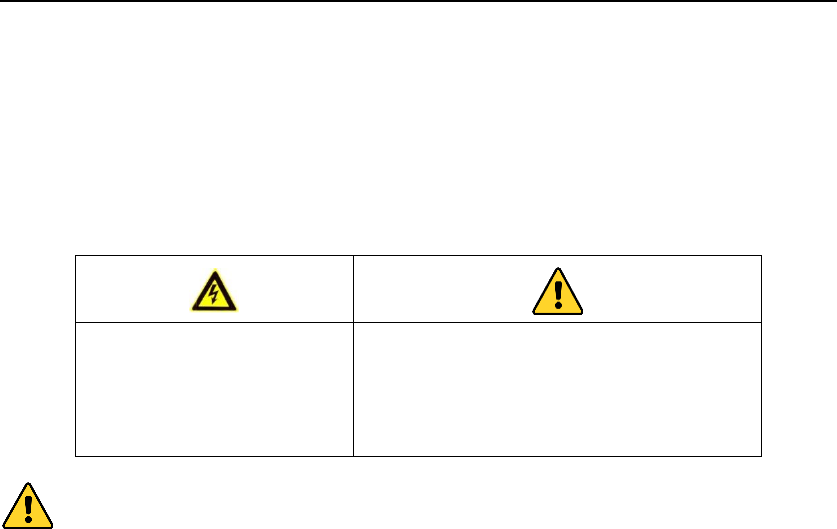
Body Camera Quick Start Guide
4
Safety Instruction
These instructions are intended to ensure that user can use the product correctly to avoid danger or property
loss.
The precaution measure is divided into “Warnings” and “Cautions”
Warnings: Serious injury or death may occur if any of the warnings are neglected.
Cautions: Injury or equipment damage may occur if any of the cautions are neglected.
Warnings
● Proper configuration of all passwords and other security settings is the responsibility of the installer and/or
end-user.
● In the use of the product, you must be in strict compliance with the electrical safety regulations of the nation
and region. Please refer to technical specifications for detailed information.
● Input voltage should meet both the SELV (Safety Extra Low Voltage) and the Limited Power Source with 5 VDC
according to the IEC60950-1 standard. Please refer to technical specifications for detailed information.
● Do not connect several devices to one power adapter as adapter overload may cause over-heating or a fire
hazard.
● Please make sure that the plug is firmly connected to the power socket.
● If smoke, odor or noise rise from the device, turn off the power at once and unplug the power cable, and then
please contact the service center.
Preventive and Cautionary Tips
Before connecting and operating your device, please be advised of the following tips:
● Make sure that all the related equipment is power-off during the installation.
● Do not place the product in high-temperature or damp environment, and do not expose it to high
electromagnetic radiation.
● If the product does not function properly, please contact your dealer or the nearest service center. Do not
disassemble the product for repair or maintenance by yourself.
● Only use the battery, power adapter and assembly parts specified by the manufacturer.
● Consult the authorized dealer or technician from Hikvision for any question and request for product using.
Warnings Follow these safeguards
to prevent serious injury or death.
Cautions Indicates a potentially hazardous situation,
which if not avoided, could result in equipment
damage, data loss, performance degradation, or
unexpected results.
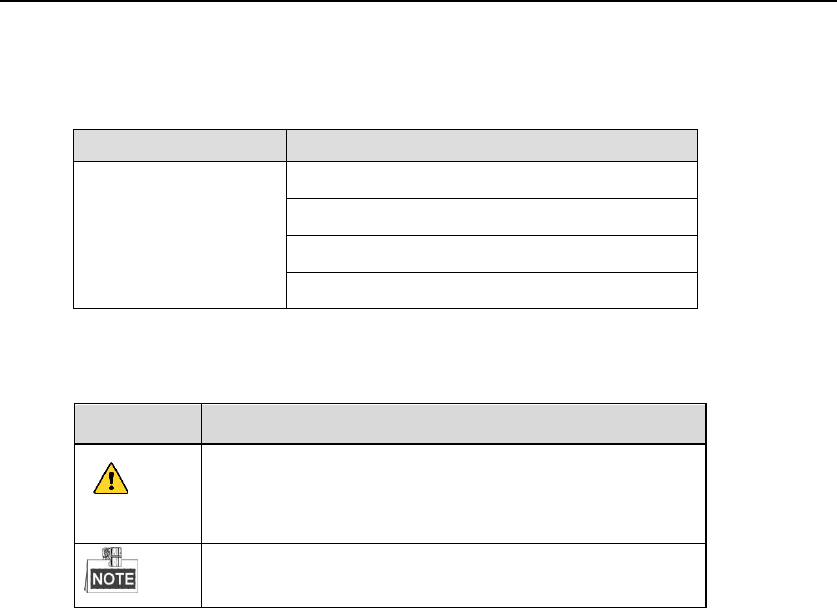
Body Camera Quick Start Guide
5
Applicable Models
This manual is applicable to the models listed in the following table.
Series
Model
DS-MH2211 Series
DS-MH2211/32G
DS-MH2211/32G/GPS/WIFI
DS-MH2211/64G
DS-MH2211/64G/GPS/WIFI
Symbol Conventions
The symbols that may be found in this document are defined as follows.
Symbol
Description
Indicates a potentially hazardous situation, which if not avoided,
could result in equipment damage, data loss, performance
degradation, or unexpected results.
Provides additional information to emphasize or supplement
important points of the main text.

Body Camera Quick Start Guide
6
TABLE OF CONTENTS
TABLE OF CONTENTS .................................................................................................................................. 6
Chapter 1Introduction ................................................................................................................................ 7
1.1 Package List ..................................................................................................................................... 7
1.2 Buttons and Interfaces ..................................................................................................................... 7
1.3 How to Charge ................................................................................................................................. 8
Chapter 2Start-up ...................................................................................................................................... 9
2.1 Start-up and Shutdown .................................................................................................................... 9
2.1.1 Start-up ............................................................................................................................... 9
2.1.2 Sleep/Wakeup ..................................................................................................................... 9
2.1.3 Shutdown ............................................................................................................................ 9
2.1.4 Force to Shutdown .............................................................................................................. 9
2.2 Menu Operation .............................................................................................................................. 9
2.3 Turning on/off IR Lights ................................................................................................................. 10
2.4 Taking Pictures ............................................................................................................................... 10
2.5 Record and Capture ....................................................................................................................... 10
2.6 Taping ............................................................................................................................................ 11
2.7 Playback ......................................................................................................................................... 11
Chapter 3Configuration .............................................................................................................................12
3.1 Network Settings ........................................................................................................................... 12
3.1.1 Turning on Wi-Fi ............................................................................................................... 12
3.1.2 Network Transmission Parameters ................................................................................... 12
3.2 Camera Settings ............................................................................................................................. 13
3.3 Positioning Settings ....................................................................................................................... 13
Chapter 4Body Camera Assistant...............................................................................................................14
4.1 Assistant Installation ...................................................................................................................... 14
4.2 Device and Assistant Connection ................................................................................................... 14
4.3 Time Synchronization .................................................................................................................... 15
4.4 Platform Settings ........................................................................................................................... 16
4.5 User Information Settings .............................................................................................................. 16
Chapter 5Troubleshooting .........................................................................................................................17
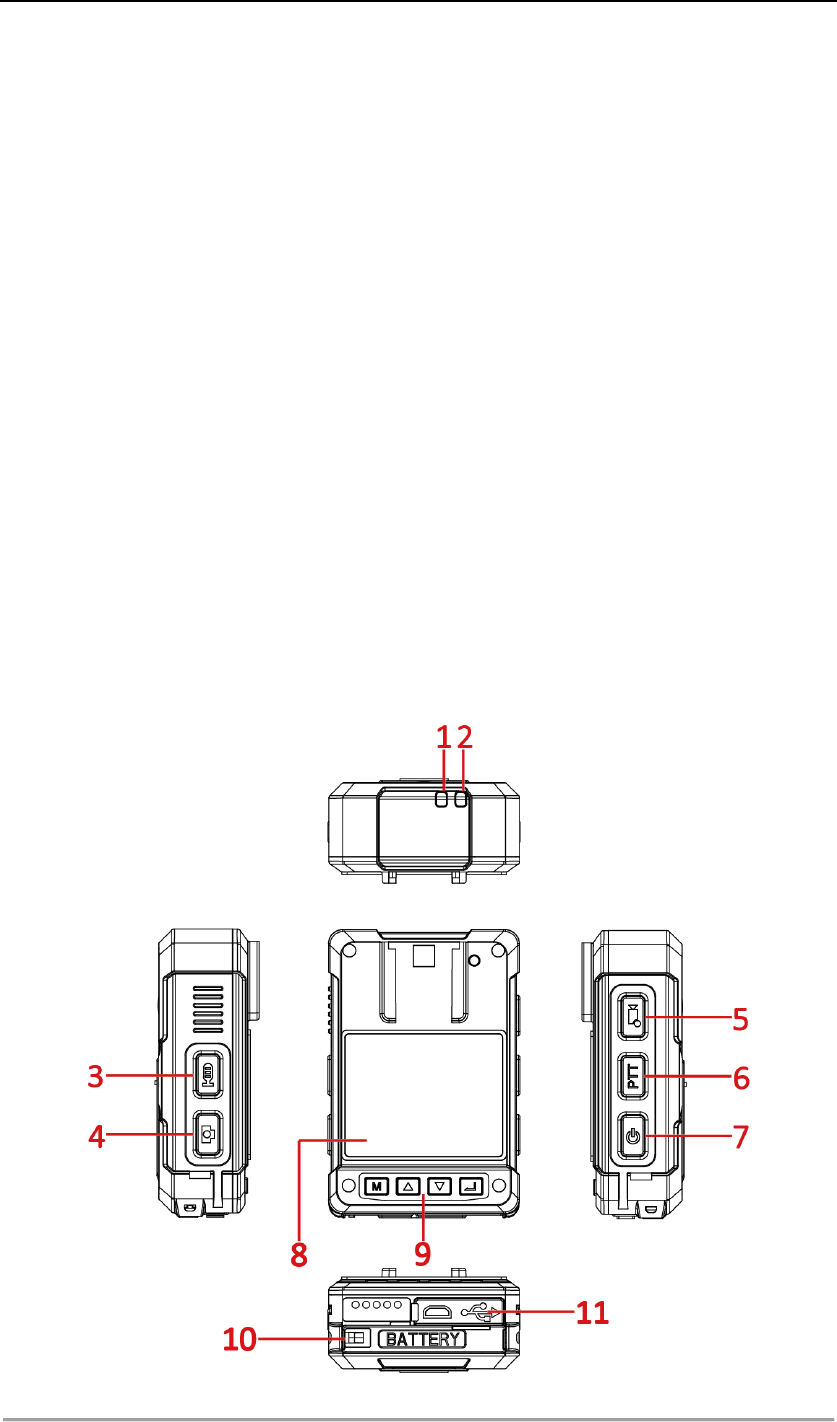
Body Camera Quick Start Guide
7
Chapter 1 Introduction
Purpose:
Body camera is a video recording system that is typically used by law enforcement officers to record their
interactions with the public and gather video evidences at crime scenes.
1.1 Package List
Following objects are included in package. If something loses, contact us or our supplier for it.
1 * Body camera.
1 * USB data cable.
1 * Charger.
1 * Demountable and angle adjustable clip
1 * CD which contains user manual and Body Camera Assistant.
1 * Printed quick start guide.
1.2 Buttons and Interfaces
Figure 1. 1 Overall View
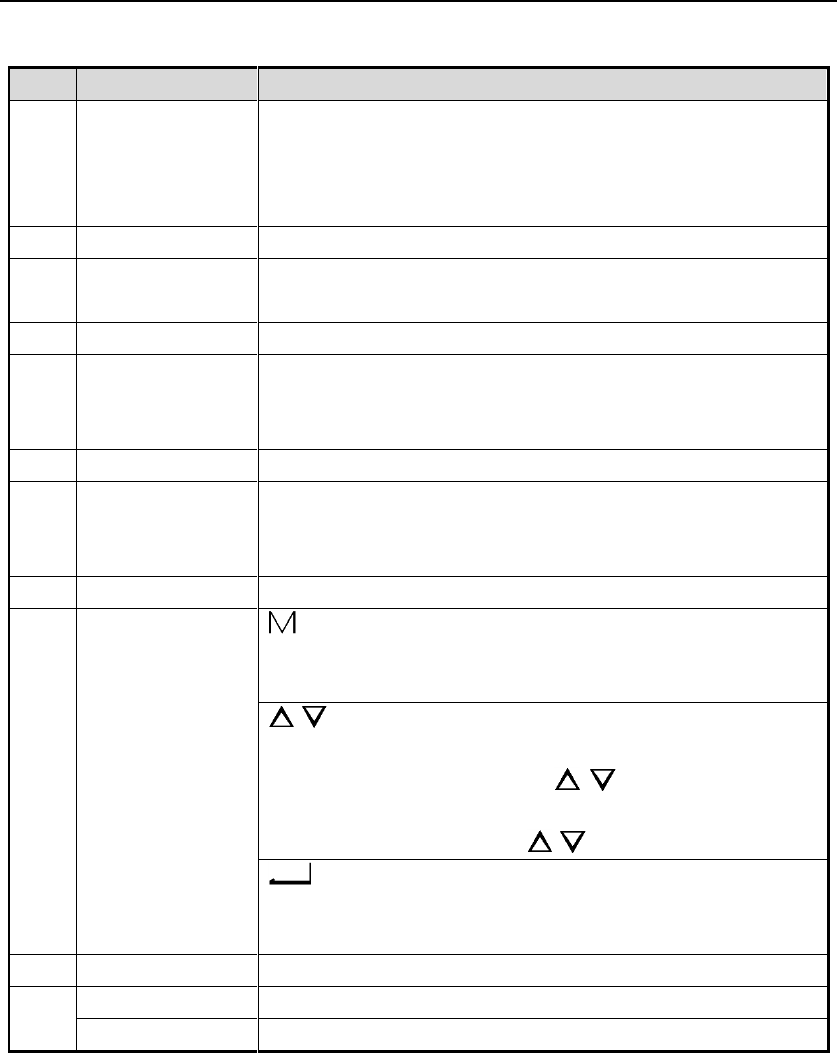
Body Camera Quick Start Guide
8
Table 1. 1 Button Description
No.
Button
Description
1
LED 1
When body camera is being charged, it is solid red.
When body camera is in low battery, it flashes in red with high
frequency.
When body camera is recording, it flashes in red with low frequency.
2
LED 2
When body camera is starting up, it is solid green.
3
Taping
Press it to start/stop taping.
Hold it for 3 seconds to turn on/off fluorescent.
4
Capture
Press it to capture current live view image.
5
Recording
Press it to start/stop recording.
Hold it for 3 seconds to turn on IR positioning light.
Hold it for 2 seconds to start up body camera and start recording.
6
PTT
Reserved.
7
Sleep/Wake
Press it for 3 seconds to start up.
Hold it for 3 seconds to turn on.
After device starts up, press it to inactivate/activate LCD.
8
LCD
It displays local menu and live view image.
9
Menu button
:
In LCD live view mode, press it to enter main menu.
In LCD menu, press it to exit.
/ :
In LCD menu, press it to navigate between fields and items in menus.
In LCD playback mode, press / to speed up/slow down
playback speed.
In LCD live view mode, press / to zoom in/out.
:
In LCD menu, press it to enter a sub-menu or confirm a selection.
In LCD live view mode, hold it for 3 seconds to set a video tag.
10
Battery
Battery slot.
11
USB interface
USB interface for charging and data transmission.
HDMI interface
HDMI interface.
1.3 How to Charge
Purpose:
Follow the steps to charge device.
Steps:
1. Open the cover of USB interface.
2. Connect body camera to the charger with the USB data cable.

Body Camera Quick Start Guide
9
Chapter 2 Start-up
2.1 Start-up and Shutdown
2.1.1 Start-up
Before you start:
Ensure the power is sufficient. If not, charge body camera. For details, refer to 1.3 How to Charge.
Step:
Hold Sleep/Wake for 3 seconds. Then the LED 2 turns green, the HIKVISION logo pops up, and you will hear an
audible notification. All of these indicate the body camera starts successfully.
2.1.2 Sleep/Wakeup
Step:
The LCD goes to sleep automatically when there is no operation in the predefined auto-lock time. Press
Sleep/Wake to manually inactivate or activate LCD.
2.1.3 Shutdown
Step:
Hold Sleep/Wake for 3 seconds. When you hear an audible notification, and the HIKVISION logo pops up on the
LCD, the LCD shut down successfully.
2.1.4 Force to Shutdown
Step:
If body camera crashed or it cannot be shut down normally, you can hold Sleep/Wake for 15 seconds to
shutdown forcedly.
Body camera will be restored to default settings.
2.2 Menu Operation
Before you start:
Wake up LCD.
Steps:
1. Press to enter main menu.
2. Press to enter the sub-menu.
Table 2. 1 Sub-Menu Description
Menu
Description
Playback
You can play back recorded videos, pictures, and audios.

Body Camera Quick Start Guide
10
Menu
Description
Camera Settings
You can set camera parameters including video resolution, bitrate, frame
rate, pre-record time, post-record time, video clip time, picture quality, and
video format.
Network Settings
You can set network transmission resolution, network transmission bitrate,
network transmission frame rate, platform connection, and Wi-Fi
parameters.
System Settings
You can set positioning parameters, time synchronization, system sound,
language, and so on.
2.3 Turning on/off IR Lights
Purpose:
The body camera provides IR (Infrared Radiation) lights. At night or dark environment, the IR light helps to get a
visible image.
Steps:
1. Enter System Settings sub-menu.
Main Menu > System Settings
2. Press / to position the cursor on Infrared item. And press to enter Infrared menu.
3. Press / to position the cursor on ON.
OFF: By default, IR light is off.
ON: In night period or dark environment, it is recommended to turn on IR light.
AUTO: Body camera automatically turns on/off IR light according to environment.
4. Press to save the settings.
2.4 Taking Pictures
Purpose:
You can take pictures of the crime scenes or other situations.
Step:
1. Enter live view mode.
2. Press to take a picture for current live view image.
The picture is saved in memory in .jpg format and named by taking picture date and time.
2.5 Record and Capture
Purpose:
You can record the videos in crime scenes or other situations. And during the recording, you can capture.
Steps:
1. Enter live view mode.
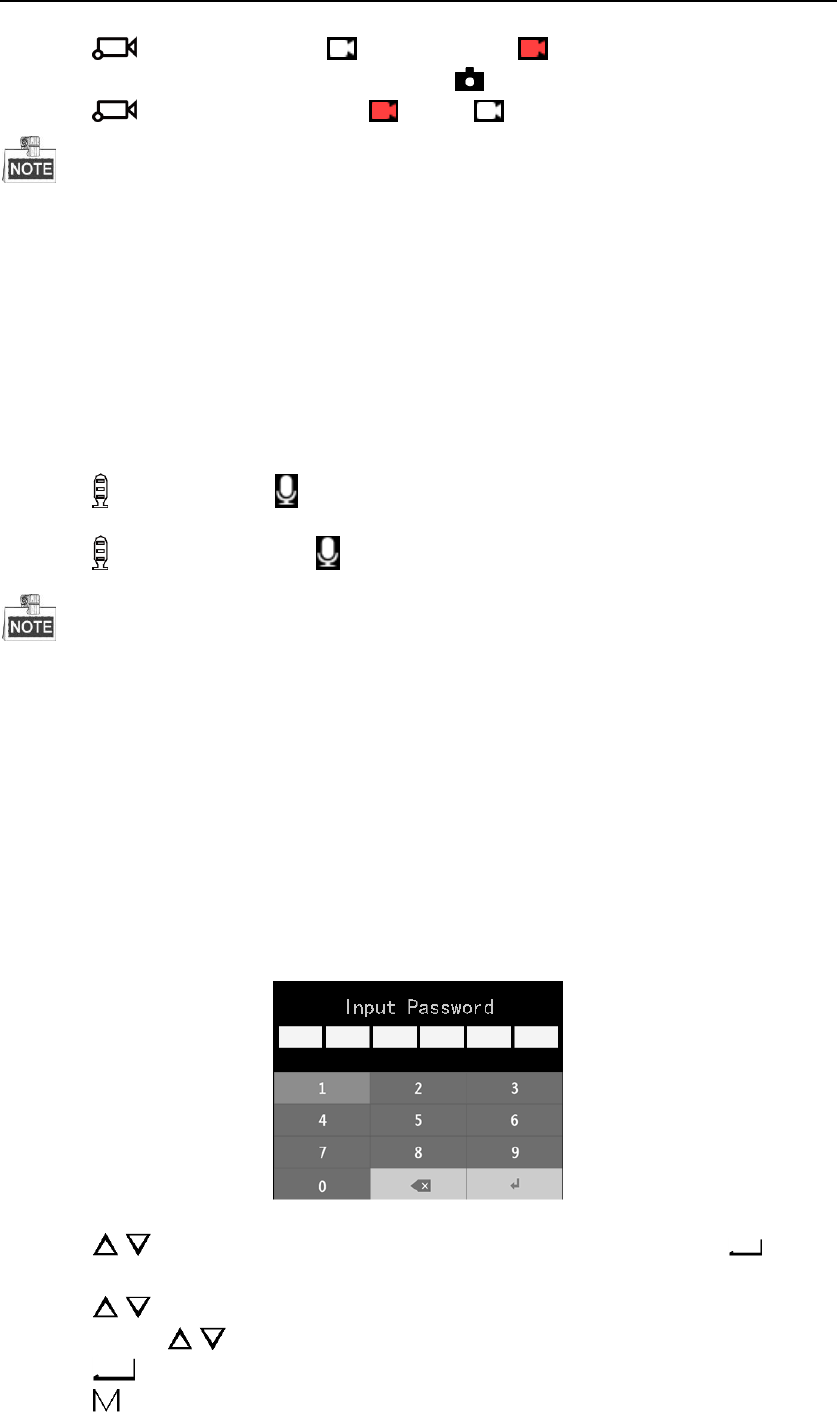
Body Camera Quick Start Guide
11
2. Press to start recording. Then in live view turns to and the LED 1 starts flashing in red.
3. Optionally, during the recording process, you can press to capture current live view image.
4. Press again to stop recording. Then turns to .
The video is saved in meory in .mp4 format and named by recording starting time.
2.6 Taping
Purpose:
You can tape audios in crime scenes or other situations.
Steps:
1. Enter live view mode.
2. Press to start taping. Then pops up in live view interface.
3. Press again to stop taping. Then disappears.
The audio file is saved in memory in .AAC format and is named by taping starting time.
2.7 Playback
Purpose:
You can play back the recorded videos, pictures, and audios.
Steps:
1. Enter Playback interface.
Main Menu > Playback
2. If Verify function is on, you need to enter device password to get permission.
Figure 2. 1 Enter Password
3. Press / to select the playback file type as Video, Picture, or Audio. And press to enter
selected type menu.
4. Press / to select data.
5. In file list, press / to select the file to play back.
6. Press to start playback.
7. Press to exit playback.
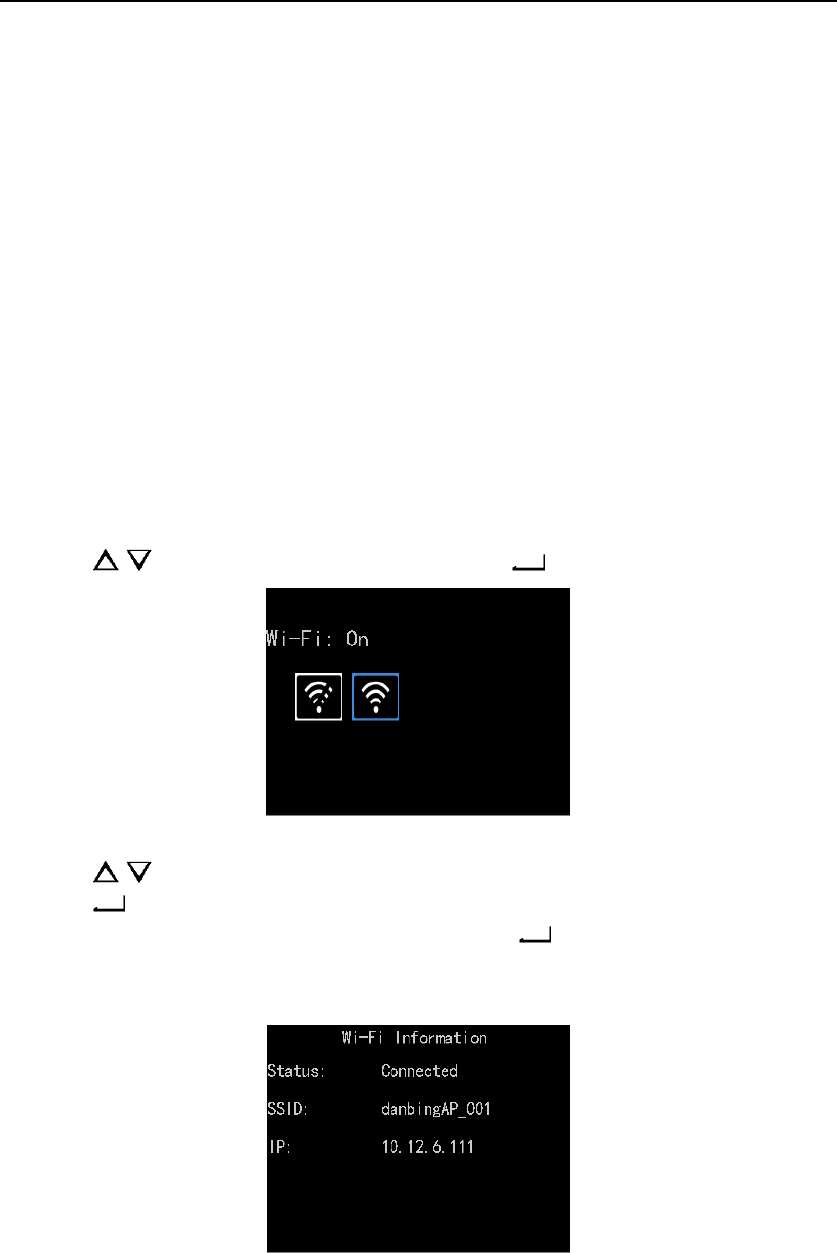
Body Camera Quick Start Guide
12
Chapter 3 Configuration
3.1 Network Settings
3.1.1 Turning on Wi-Fi
Purpose:
You can access internet by connecting to a Wi-Fi.
Before you start:
Configure Wi-Fi parameters in body camera assistant. For detailed steps, refer to user manual.
Steps:
1. Enter Network Settings interface.
Main Menu > Network Settings
2. Press / to position the cursor on Wi-Fi item. And press to enter Wi-Fi menu.
Figure 3. 1 Wi-Fi Settings
3. Press / to select Wi-Fi as On.
4. Press to save the settings.
5. Then the prompt “Reboot device to take effect.” pops up. Press to reboot.
6. You can view the Wi-Fi Status, SSID, and IP in Wi-Fi Information interface.
Main Menu > Network Settings > Wi-Fi Information
Figure 3. 2 Wi-Fi Information
3.1.2 Network Transmission Parameters
Purpose:
By setting network transmission parameters, you can determine the resolution, frame rate, and bitrate used by

Body Camera Quick Start Guide
13
iVMS platform when it views body camera image.
Steps:
1. Enter Network Settings interface.
Main Menu > Network Settings
2. Press / to position the cursor on Net Resolution, Net Bitrate, or Net Frame Rate. And press
to enter corresponding menu.
3. Press / to select target parameter.
4. Press to save the settings.
3.2 Camera Settings
Purpose:
You can set the video parameters, including resolution, frame rate, bitrate, and so on.
Steps:
1. Enter Camera Settings interface.
Main Menu > Camera Settings
2. Press / to position the cursor on Video Resolution, Bitrate, Frame Rate, Pre-Record, Post-Record,
or other items. And press to enter corresponding menu.
3. Press / to select target parameter.
4. Press to save the settings.
5. Reboot device to take effect the new settings.
3.3 Positioning Settings
Purpose:
Body camera has a built-in positioning module. By turning on positioning function, the device can obtain the
latitude, longitude, and speed information. The information will be displayed in live view.
Before you start:
Ensure the body camera locates in a place the positioning signal exists.
Steps:
1. Enter Camera Settings interface.
Main Menu > System Settings
2. Press / to position the cursor on Positioning item. And press to enter Positioning menu.
3. Press / to select positioning type as Off, GPS, BeiDou, or GPS and BeiDou.
4. Press to save the settings. If positioning succeeded, the positioning icon in live view will turn from
to .

Body Camera Quick Start Guide
14
Chapter 4 Body Camera Assistant
Purpose:
Log into body camera via the Body Camera Assistant to view device’s logs, videos, audios, and pictures, and
configure parameters remotely.
Assistant mentioned below refers to the Body Camera Assistant.
4.1 Assistant Installation
Purpose:
The installation package BodyCameraAssistant-win32.exe is delivered with the CD.
Steps:
1. Double-click the BodyCameraAssistant-win32.exe to start installing.
2. Follow the wizard to install the assistant.
4.2 Device and Assistant Connection
Purpose:
You need to connect the assistant with body camera via the USB data cable.
Before you start:
Connect the body camera to your computer with the USB cable.
Steps:
1. Click the icon to start the assistant.
2. Click Recognize device button to start recognizing. Then the recognized device will be listed.
Figure 4. 1 Recognized Device
3. Click the recognized device, input device password, and then click Login to log in. Then the configuration
interface shows.
STRONG PASSWORD RECOMMENDED–We highly recommend you create a strong password of your own
choosing (Using a minimum of 8 characters, including at least three of the following categories: upper case letters,
lower case letters, numbers, and special characters.) in order to increase the security of your product. And we
recommend you reset your password regularly, especially in the high security system, resetting the password
monthly or weekly can better protect your product.
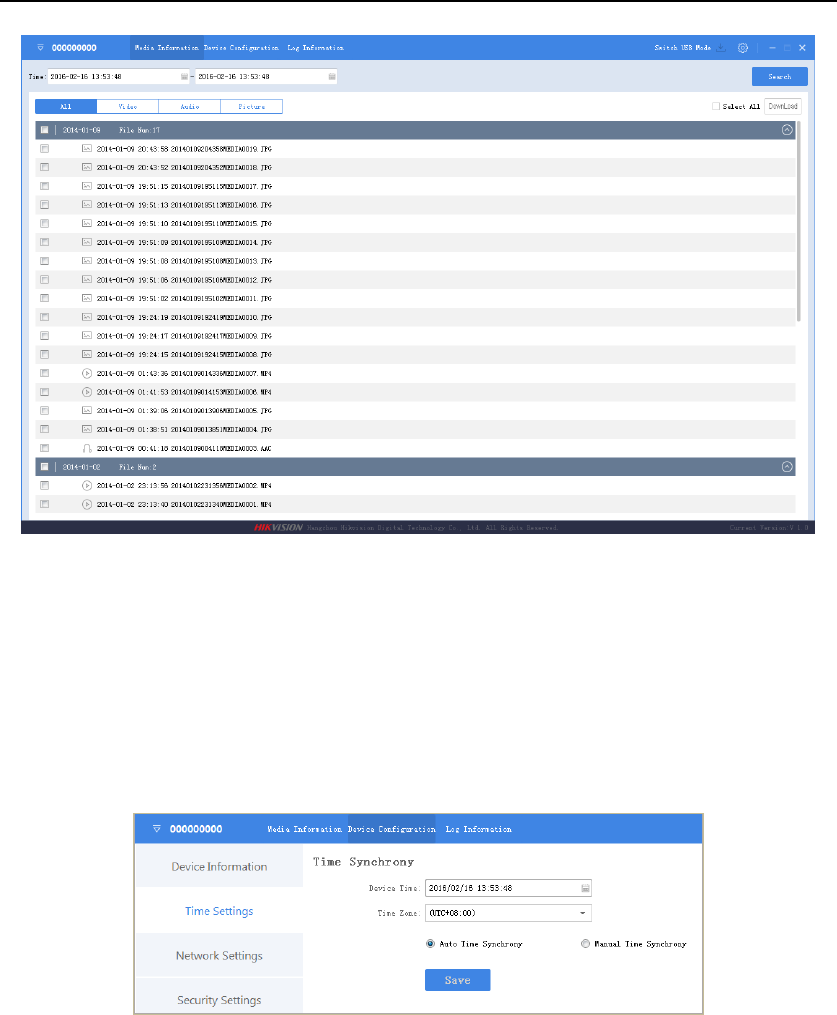
Body Camera Quick Start Guide
15
Figure 4. 2 Body Camera Assistant
4.3 Time Synchronization
Purpose:
You can synchronize device time with your custom time or network time.
Steps:
1. Click the Device Configuration tab, and click Time Settings item in the left menu list.
Figure 4. 3 Time Settings
2. You can select time synchronization type as Auto Time Synchrony or Manual Time Synchrony by checking
corresponding checkbox.
Auto Time Synchrony: If selected, Device Time isn’t configurable. Assistant will synchronize the
device time with the NTP server time.
Manual Time Synchrony: If selected, you can synchronize device time according your custom time.
3. If Auto Time Synchrony is selected, select the Time Zone according to your needs.
If Manual Time Synchrony is selected, select the Device Time and Time Zone according to your needs.
4. Click Save to save the settings.
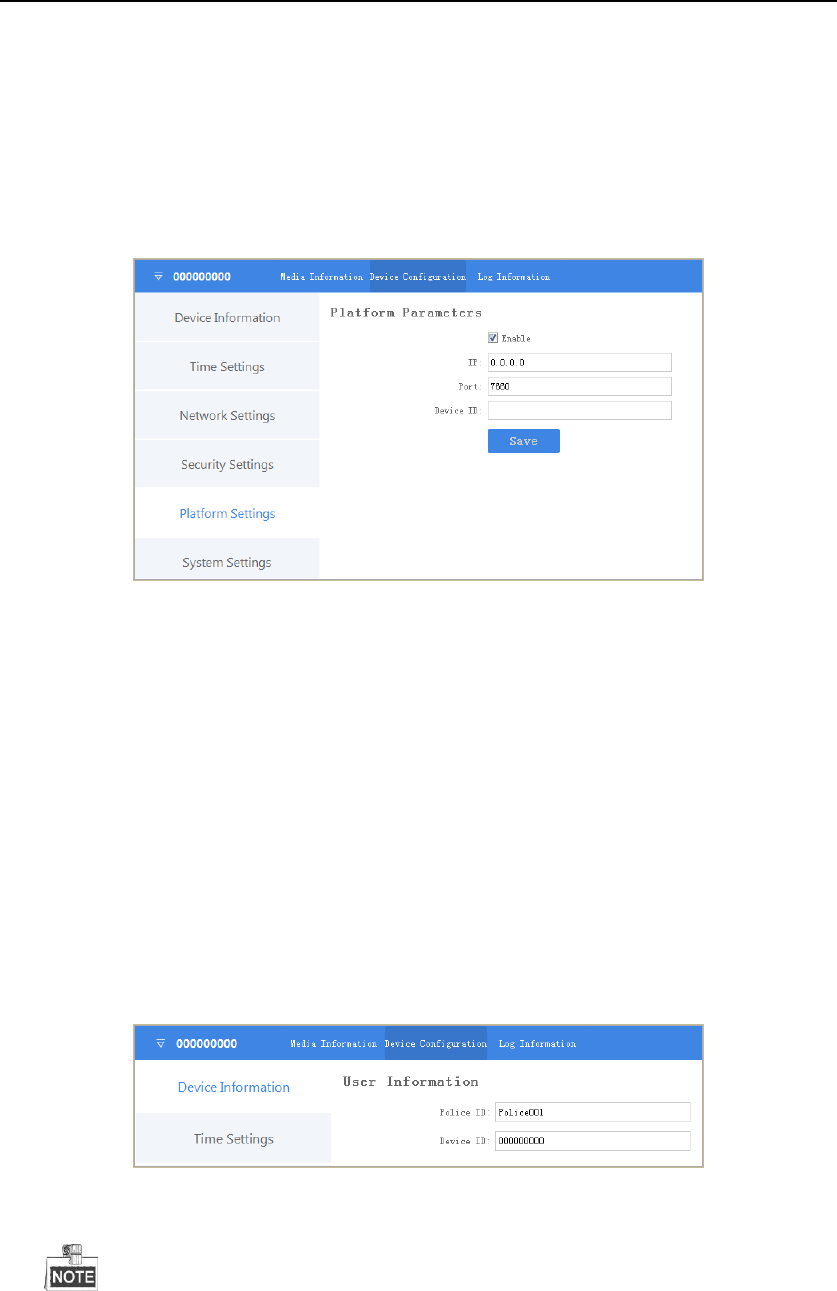
Body Camera Quick Start Guide
16
4.4 Platform Settings
Purpose:
You can log in device via iVMS platform, to monitor device, receive alarms, and so on.
Steps:
1. Click the Device Configuration tab, and click Platform Settings item in the left menu list.
Figure 4. 4 Platform Settings
2. Check the checkbox of Enable to enable platform connection.
3. Edit IP, Port, and Device ID.
IP: The IP address of platform server you want to connect.
Port: The port of platform. The default port of iVMS is 7660.
Device ID: When adding device via platform, the ID is needed. It is device’s unique identification.
4.5 User Information Settings
Purpose:
You can customize the police ID and device ID.
Steps:
1. Click the Device Configuration tab, and click Device Information item in the left menu list.
Figure 4. 5 User Information
2. You can edit the Police ID and Device ID.
Both Police ID and Device ID cannot be longer than 32 characters.
3. Click Save to save the settings.

Body Camera Quick Start Guide
17
Chapter 5 Troubleshooting
Unable to start up.
a) Possible Reason: Device runs out of power.
Solution: Get device be charged.
b) Possible Reason: Device is abnormal.
Solution: Hold the Sleep/Down button for 15 seconds to reset device.
Unable to start recording.
a) Possible Reason: Memory is full.
Solution: Back up device and clear device memory.
b) Possible Reason: Formatting memory error.
Solution: Format the memory via assistant. For detailed steps, refer to 7.5.7 Formatting in user manual.
Unable to log in.
a) Possible Reason: Password error.
Resolution: Reset your password. For detailed steps, refer to 7.5.8 System Resetting in user manual.
b) Possible Reason: Device is abnormal.
Resolution: Reboot device.
0100001060129

Body Camera Quick Start Guide
18
